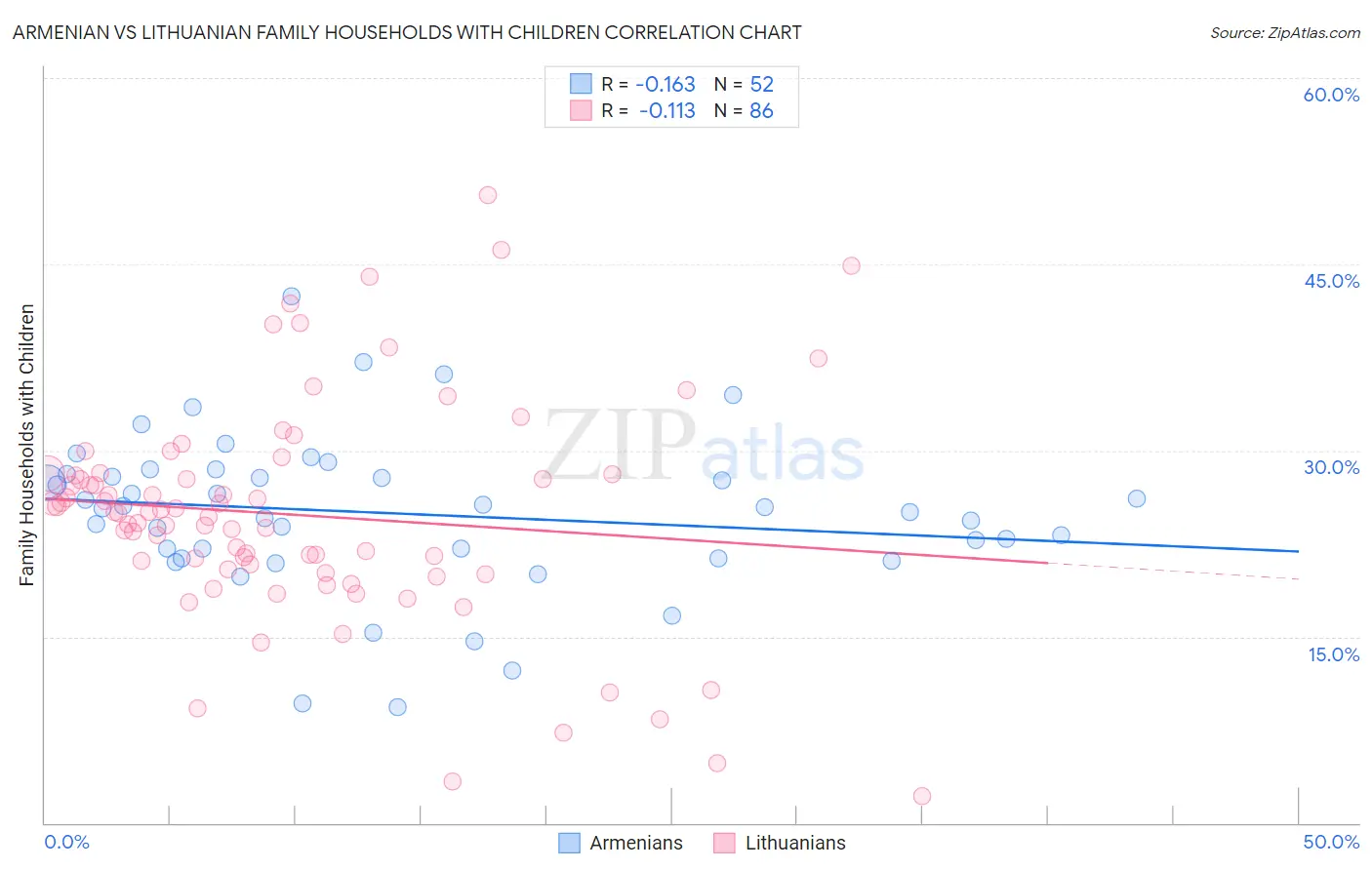Armenian vs Lithuanian Family Households with Children
COMPARE
Armenian
Lithuanian
Family Households with Children
Family Households with Children Comparison
Armenians
Lithuanians
26.4%
FAMILY HOUSEHOLDS WITH CHILDREN
0.1/ 100
METRIC RATING
297th/ 347
METRIC RANK
26.6%
FAMILY HOUSEHOLDS WITH CHILDREN
0.3/ 100
METRIC RATING
281st/ 347
METRIC RANK
Armenian vs Lithuanian Family Households with Children Correlation Chart
The statistical analysis conducted on geographies consisting of 310,641,261 people shows a poor negative correlation between the proportion of Armenians and percentage of family households with children in the United States with a correlation coefficient (R) of -0.163 and weighted average of 26.4%. Similarly, the statistical analysis conducted on geographies consisting of 421,521,006 people shows a poor negative correlation between the proportion of Lithuanians and percentage of family households with children in the United States with a correlation coefficient (R) of -0.113 and weighted average of 26.6%, a difference of 0.59%.

Family Households with Children Correlation Summary
| Measurement | Armenian | Lithuanian |
| Minimum | 9.3% | 2.2% |
| Maximum | 42.4% | 50.6% |
| Range | 33.1% | 48.4% |
| Mean | 24.9% | 24.8% |
| Median | 25.4% | 25.0% |
| Interquartile 25% (IQ1) | 21.7% | 20.4% |
| Interquartile 75% (IQ3) | 28.0% | 28.1% |
| Interquartile Range (IQR) | 6.3% | 7.7% |
| Standard Deviation (Sample) | 6.3% | 9.1% |
| Standard Deviation (Population) | 6.3% | 9.0% |
Demographics Similar to Armenians and Lithuanians by Family Households with Children
In terms of family households with children, the demographic groups most similar to Armenians are Croatian (26.4%, a difference of 0.010%), Macedonian (26.4%, a difference of 0.030%), Immigrants from Western Europe (26.4%, a difference of 0.10%), Latvian (26.4%, a difference of 0.11%), and Trinidadian and Tobagonian (26.4%, a difference of 0.11%). Similarly, the demographic groups most similar to Lithuanians are French American Indian (26.6%, a difference of 0.010%), Immigrants from North America (26.6%, a difference of 0.080%), Senegalese (26.6%, a difference of 0.090%), Immigrants from Canada (26.5%, a difference of 0.10%), and Finnish (26.6%, a difference of 0.12%).
| Demographics | Rating | Rank | Family Households with Children |
| Finns | 0.4 /100 | #279 | Tragic 26.6% |
| Senegalese | 0.4 /100 | #280 | Tragic 26.6% |
| Lithuanians | 0.3 /100 | #281 | Tragic 26.6% |
| French American Indians | 0.3 /100 | #282 | Tragic 26.6% |
| Immigrants | North America | 0.3 /100 | #283 | Tragic 26.6% |
| Immigrants | Canada | 0.3 /100 | #284 | Tragic 26.5% |
| Cambodians | 0.2 /100 | #285 | Tragic 26.5% |
| Immigrants | Senegal | 0.2 /100 | #286 | Tragic 26.5% |
| Shoshone | 0.2 /100 | #287 | Tragic 26.5% |
| Russians | 0.2 /100 | #288 | Tragic 26.5% |
| Immigrants | Sweden | 0.2 /100 | #289 | Tragic 26.5% |
| Albanians | 0.2 /100 | #290 | Tragic 26.5% |
| Bahamians | 0.2 /100 | #291 | Tragic 26.5% |
| Poles | 0.2 /100 | #292 | Tragic 26.5% |
| Blacks/African Americans | 0.1 /100 | #293 | Tragic 26.5% |
| Latvians | 0.1 /100 | #294 | Tragic 26.4% |
| Macedonians | 0.1 /100 | #295 | Tragic 26.4% |
| Croatians | 0.1 /100 | #296 | Tragic 26.4% |
| Armenians | 0.1 /100 | #297 | Tragic 26.4% |
| Immigrants | Western Europe | 0.1 /100 | #298 | Tragic 26.4% |
| Trinidadians and Tobagonians | 0.1 /100 | #299 | Tragic 26.4% |